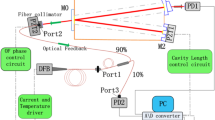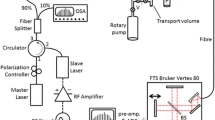Abstract
The paper presents a signal processing system used for nitrogen dioxide detection employing cavity enhanced absorption spectroscopy. In this system, the absorbing gas concentration is determined by the measurement of a decay time of a light pulse trapped in a cavity.
The setup includes a resonance optical cavity, which was equipped with spherical and high reflectance mirrors, the pulsed diode laser (414 nm) and electronic signal processing system. In order to ensure registration of low-level signals and accurate decay time measurements, special preamplifier and digital signal processing circuit were developed.
Theoretical analyses of main parameters of optical cavity and signal processing system were presented and especially signal-to-noise ratio was taken into consideration. Furthermore, investigation of S/N signal processing system and influence of preamplifier feedback resistance on the useful signal distortion were described.
The aim of the experiment was to study potential application of cavity enhanced absorption spectroscopy for construction of fully optoelectronic NO2 sensor which could replace, e.g., commonly used chemical detectors. Thanks to the developed signal processing system, detection limit of NO2 sensor reaches the value of 0.2 ppb (absorption coefficient equivalent = 2.8 × 10−9 cm−1).
Similar content being viewed by others
References
J.M. Herbelin and J.A. McKay, “Development of laser mirrors of very high reflectivity using the cavity-attenuated phase-shift method”, Appl. Optics 20, 3341–3344 (1981).
A. O’Keefe and D.A.G. Deacon, “Cavity ring-down optical spectrometer for absorption measurements using pulsed laser sources”, Rev. Sci. Instrum. 59, 2544–2554 (1988).
J. Wojtas, A. Czyżewski, T. Stacewicz, Z. Bielecki, and J. Mikołajczyk, “Cavity enhanced spectroscopy for NO2 detection”, Proc. SPIE 5954, 174–178 (2005).
V.L. Kasyutich, C.S.E. Bale, C.E. Canosa-Mas, C. Pfrang, S. Vaughan, and R.P. Wayne, “Cavity-enhanced absorption: detection of nitrogen dioxide and iodine monoxide using a violet laser diode”, Appl. Phys. B76, 691–698 (2003).
J. Wojtas, A. Czyżewski, T. Stacewicz, and Z. Bielecki, “Sensitive detection of NO2 with cavity enhanced spectroscopy”, Opt. Appl. 36, 461–467 (2006).
K.W. Busch and M.A. Busch, Cavity-Ringdown Spectroscopy, ACS Symposium series, American Chemical Society, Washington DC, 1999.
Z. Bielecki, “Maximisation of signal-to-noise ratio in infrared receivers”, Opto-Electron. Rev. 10, 209–216 (2006).
Z. Bielecki, “Readout electronics for optical detectors”, Opto-Electron. Rev. 12, 129–137 (2004).
A. Rogalski and Z. Bielecki, “Detection of optical radiation” in Handbook of optoelectronics, Vol. 1, pp. 73–117, edited by J.P. Dakin and R.W.G. Brown, Taylor&Francis, USA, 2006.
S.O. Flyckt and C. Marmonier, Photomultiplier Tubes, Principles, and Applications, Photonics, Brive, 2002.
A.G. Wright, “Why photomultipliers need amplifiers?”, Electron Tubes Ltd, Technical reprint R/P093, http://www.electrontubes.com.
Author information
Authors and Affiliations
Corresponding author
About this article
Cite this article
Wojtas, J., Bielecki, Z. Signal processing system in cavity enhanced spectroscopy. Opto-Electron. Rev. 16, 420–427 (2008). https://doi.org/10.2478/s11772-008-0034-z
Published:
Issue Date:
DOI: https://doi.org/10.2478/s11772-008-0034-z




